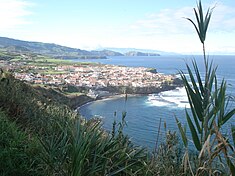Maia (Ribeira Grande)
| Maia | |
| Civil Parish | |
|
The coastal village of Maia, as seen from the hilltop belvedere
|
|
| Official name: Freguesia da Maia | |
| Country | |
|---|---|
| Autonomous Region | |
| Island | São Miguel |
| Municipality | Ribeira Grande |
| Localities | Maia, Lombinha da Maia, Calços da Maia, Gorreana |
| Center | Maia |
| - elevation | 27 m (89 ft) |
| - coordinates | 37°49′57″N 25°23′18″W / 37.83250°N 25.38833°WCoordinates: 37°49′57″N 25°23′18″W / 37.83250°N 25.38833°W |
| Highest point | Lomba dos Bezerros |
| - elevation | 758 m (2,487 ft) |
| - coordinates | 37°47′4″N 25°24′56″W / 37.78444°N 25.41556°W |
| Lowest point | Sea level |
| - location | Atlantic Ocean |
| - elevation | 0 m (0 ft) |
| Area | 21.97 km2 (8 sq mi) |
| - water | .007 km2 (0 sq mi) |
| - urban | .48 km2 (0 sq mi) |
| Population | 1,900 (2011) |
| Density | 86/km2 (223/sq mi) |
| LAU | Junta Freguesia |
| - location | Rua Santa Catarina |
| - elevation | 22 m (72 ft) |
| - coordinates | 37°49′58″N 25°23′13″W / 37.83278°N 25.38694°W |
| President Junta | Jaime Manuel Serpa da Costa Rita |
| President Assembleia | Graça Borges Castanho |
| Timezone | Azores (UTC-1) |
| - summer (DST) | Azores (UTC0) |
| Postal Zone | 9625-337 |
| Area Code & Prefix | (+351) 292 XXX-XXXX |
| Demonym | Maiense |
| Patron Saint | Divino Espírito Santo |
| Website: http://www.maia-saomiguel.net/ | |
Maia is a civil parish in the municipality of Ribeira Grande in the Portuguese archipelago of the Azores. The population in 2011 was 1,900, in an area of 21.97 km². Maia is the largest parish by area in Ribeira Grande.
The first Azorean historians referred to this parish, owing to the settlement of Inês da Maia, a noblewoman that established a home here in the 15th century.
The settlement of the community dates back to the early settlement of Ribeira Grande; the construction of the main church was begun at the end of the 15th century. By 1522, it had its third vicar. Maia became one of the northern coasts more rapidly growing places: one hundred years after its foundation it had become a civil parish. Its fertile terrains, one of the more productive on the island of São Miguel, and its port access, meant that small industry developed easily in this area. In particular, the tobacco, tea and cement industries developed over the course of the next centuries. Maia was also the location and headquarters for one of the first passenger transport companies on the island.
The parochial church was dedicated to the Holy Spirit in 1812, constructed after a 16th-century chapel, and expanded in 17th and 18th centuries. The Solar do Lalém, constructed at the end of the 19th century, with chapel and 18th-century portal.
In the area of Gorreana, thus named for the fact that the first resident was a man named Gorreana or gorro de Ana, who owned a tea plantation, a rare thing in Europe. This area is also the location of the Chapel of Nossa Senhora do Resgate (Portuguese: Ermida de Nossa Senhora do Resgate), from the 18th century, constructed with a decorative facade by the local farmers. In its interior, azulejos were assembled on the altar with a medallion and the patron saint in the same decoration.
In the area of Lombinha da Maia, named for its location on a small hill/escarpment (Portuguese: lombinha), a small chapel was constructed in 1896, to the invocation of Nossa Senhora das Dores. Later it was adapted, with a baptistery and sacristy to support the parishioners.
On 27 October 1919, a commission was installed to establish a religious Brotherhood, dedicated to the Holy Spirit of Maia (Portuguese: Santa Casa do Divino Espírito Santo da Maia) was convened. In 1943, the group erected a cornerstone for the local hospital, inaugurated on 24 September 1944. With the acquisition of the local pharmacy in 1946, the Santa Casa supported the population from Porto Formoso until Fenais da Ajuda.
...
Wikipedia

